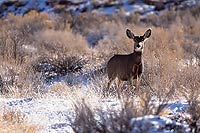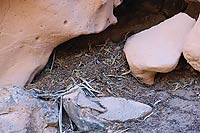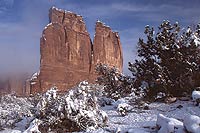 January is a transitional time in Canyon Country. The heat of summer has dialed down and the crowds are absent. Some wildlife species are deep within their winter slumbers while others have literally flown the coop to warmer climates in southern Mexico and Central America. Silence permeates the canyons and mesa tops as access is denied due to snow and ice. It’s a time where one can almost hear a collective sigh by residents, both 2- and 4-legged, as if the pause button is stuck for the time being.
January is a transitional time in Canyon Country. The heat of summer has dialed down and the crowds are absent. Some wildlife species are deep within their winter slumbers while others have literally flown the coop to warmer climates in southern Mexico and Central America. Silence permeates the canyons and mesa tops as access is denied due to snow and ice. It’s a time where one can almost hear a collective sigh by residents, both 2- and 4-legged, as if the pause button is stuck for the time being.
Snow and ice may seem like an oxymoron in this landscape, but this high desert area is not immune to winter’s icy touch. Snow may blanket the land and the freeze-thaw cycle that churns away may transform this snow into patches of ice which gives the term slickrock a new definition. Even the wildlife has to tread with caution.
Though winter storms and ice-coated sandstone may inhibit human exploration, many wildlife species remain active throughout this challenging season. Small rodents and mammals such as desert cottontails, black-tailed jackrabbits, Ord’s kangaroo rats, and bushy-tailed woodrats don’t wile away the winter in hibernation but forage for food across the frozen landscape. Cottontails and jackrabbits may alter their diet to include more twigs and buds in winter since grasses are scarce or covered with snow. These members of the hare family also get much of their moisture from the plants they eat, as does the Ord’s kangaroo rat.
Though their tracks and burrows may be easily seen in the sandy desert areas, these kangaroo rats are mainly active at night. Their long hind feet and hopping nature give them their common name, and these small mammals feed on grass and other seeds, as well as dried vegetation. Also, able to obtain their moisture needs from plant material, these creatures remain active during the winter months.
Like the kangaroo rat, bushy-tailed woodrats are also active during the winter. These “packrats” build a complex nest under a rock overhang or in an alcove that is made up of twigs, bones, tree bark, fecal material, urine, and other plant material such as dried cactus pads, pine needles, and fresh greenery. Sometimes shiny objects like keys and silverware are also hauled into these nests.
These packrat middens have become focal points for paleoecologists who study Pleistocene climate change. The middens are treasure chests of time as the woodrats collect plant and animal material close to their den sites. Bits of pollen, seeds, and leaves yield information about plants that once grew in the area but are now found at higher elevations due to a drying climate. Animal bones, dung, and teeth may be from prehistoric creatures that once roamed these lands but became extinct like bison, Harrington’s mountain goat, and others. Changes in plant and animal communities reveal how climate has affected the local landscape.
These and other small mammals also keep another group of animals active during the winter: their predators. Coyotes, foxes, badgers, river otters, and birds of prey feed upon these small creatures or, as in the case of the otters, take fish from the river. It’s a challenging time for both predator and prey as cold temperatures and general health take its toll.
So, during the winter (and other seasons, too), give wildlife a break (or brake!). Observe them from a distance or investigate their tracks imprinted onto the winter landscape.